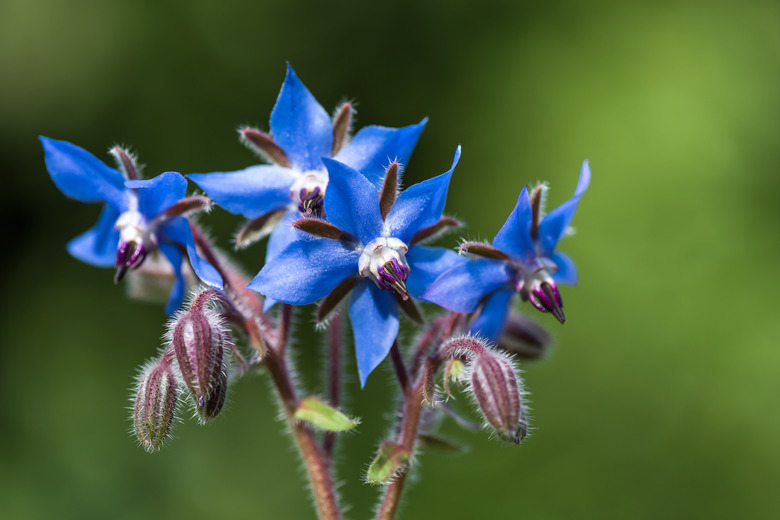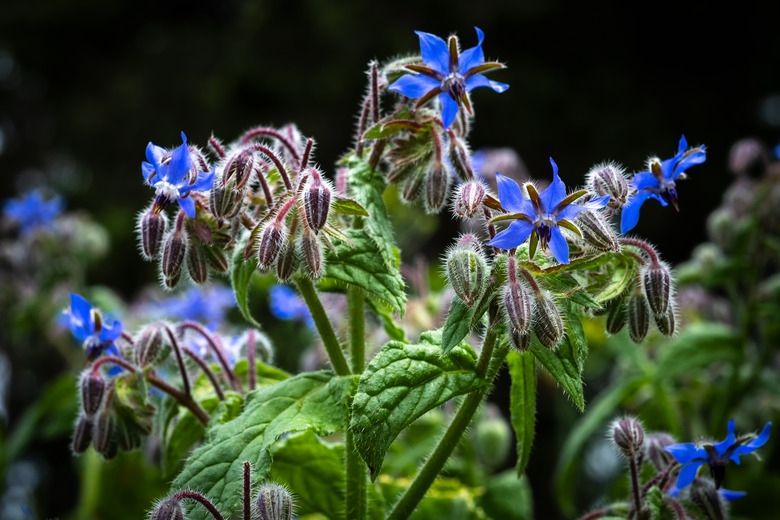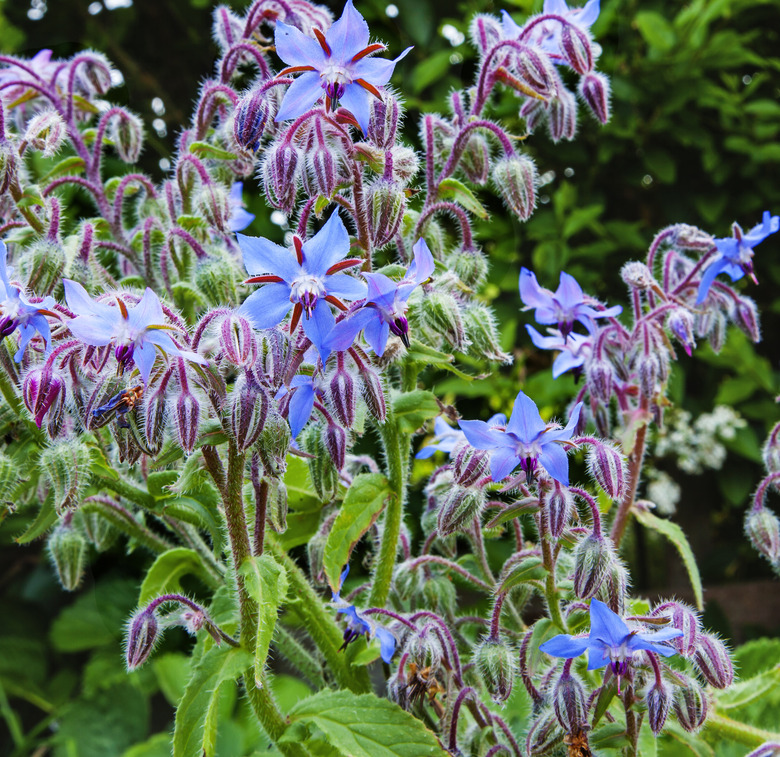How To Grow Borage
We may receive a commission on purchases made from links.
- Best uses for borage
- How to grow borage
- In what zone does borage grow best?
- When should you sow borage seeds?
- Soil, sunlight and water recommendations for borage
- How to propagate borage
- How to winterize borage
- How to harvest borage
- Common pests and other problems for borage
- Common diseases for borage
Borage (Borago officinalis) is a sprawling, rough-textured annual plant normally grown as a vegetable or herb, though it also is an attractive plant in the landscape. Most varieties have blue flowers, though there are also white-flowered types. When eaten as a vegetable, the young, tender leaves are used in salads or as garnishes, where they lend a cucumber-like flavor. The fresh leaves are sometimes boiled and used in the same way that spinach is used in recipes, but the leaves soon lose their flavor once they are dried. The colorful flowers are sweet to the taste and are sometimes used to decorate desserts and drinks.
Growing 1 to 3 feet tall with 6-inch-long, gray-green leaves, borage has drooping, star-shaped blue flowers that can bloom profusely throughout the summer if conditions are favorable. It is a fast-maturing, easy-to-grow annual that self-seeds very readily. A patch of borage will sustain itself through volunteers that pop up in the spring from seeds dropped from dried flowers. Borage can, therefore, be used almost like a perennial plant, even though the roots are not hardy and individual plants live only one season.
In traditional herbal medicine, tinctures, oil extracts and powdered borage have been used to treat a variety of digestive, respiratory and cardiac conditions. However, regular medicinal use of the highly condensed oil or ground powder is now discouraged by some experts since the plant is known to contain pyrrolidine alkaloids, which are known for liver toxicity when consumed in a high quantity. However, the routine consumption of leaves and flowers in cooking poses no danger.
Best Uses for Borage
Best Uses for Borage
Borage is generally planted by gardeners who want the leaves and flowers for a variety of cooking uses. Along with using the leaves in salads and as an ingredient in prepared recipes, some people like to freeze the small borage blossoms into ice cubes for serving in cocktails.
On a practical level, the sweet-smelling borage flowers are a good addition to any edible garden since they draw pollinators to the garden. Strawberry growers in particular find that borage encourages bees to visit and improves pollination of the flowers, leading to a more plentiful berry harvest. Borage is a good companion crop for tomatoes and squash because of its ability to attract pollinators.
Borage also has a valid role in the ornamental garden. This is a somewhat unusual plant in mixed borders, and the plentiful, intense blue flowers with the unique star shape will draw plenty of attention. It is a good plant to fill garden areas that have dry, poor soil where other plants may struggle.
How to Grow Borage
How to Grow Borage
- Common Name: Borage, starflower
- Botanical Name: Borago officinalis
- When to Plant: Seeds are best sown in spring after the last frost has passed
- USDA Zones: 2-11; a true annual that grows nearly anywhere
- Sun Exposure: Full sun
- Soil Type: Well-drained, medium-moisture to dry soil
- When it's in Trouble: Blackened, soft stalks that topple over; leggy stems with few flowers; fungal leaf spots or powdery residue on leaves
- When it's Thriving: Large, gray-green leaves on sturdy stems; profuse, vivid flowers
Starting Borage From Seed
Starting from seed is the most common way to plant borage. This plant is not commonly sold in garden centers, so seeds must be purchased from online retailers. Plant the seeds in the garden after the last frost date, or you can start them indoors several weeks before the last expected frost in your region.
Sow the seeds 1/4 to 1/2 inch deep in rows spaced about 12 inches apart and keep them consistently moist by misting the soil daily until the seedlings appear. When the seedlings are 4 to 6 inches tall, thin them out to a spacing of about 12 inches. If you wish, the tips of the growing plant can be periodically pinched off to create a bushier specimen. This will create more small, tender leaves for eating but be aware that you will sacrifice some of the flowers to accomplish this. It usually takes 55 to 75 days for a borage plant to go from germination to flowering maturity. Like most annuals, this is a rather fast-growing plant.
Once you have started growing borage in your garden, it's rarely necessary to buy additional seeds unless you want to try a new variety. Seeds from existing plants can be easily gathered and saved for future planting. Watch the blooms carefully and when the flowers begin to turn brown, collect the seeds and store them in a cool, dry location until next spring's planting time. If you simply let the flowers go to seed on the stalks, they will routinely self-seed in the garden.
After the bloom period is done for the year, pull out the plants. The next spring, watch for volunteer seedlings sprouting up in the same location. These can be thinned out each spring to create a borage patch that sustains itself perpetually.
In addition to the native species plant, there are two other varieties of borage to consider when you are purchasing seeds:
- Borago officinalis var. Variegata is similar to common borage except the leaves are mottled with white. The flowers are a slightly less intense shade of blue.
- Borago officinalis var. Alba is also known as white borage. It blooms later in the season than the blue varieties, and it has attractive white flowers. Alba is a somewhat stronger plant than common borage and is less susceptible to flopping over.
In What Zone Does Borage Grow Best?
In What Zone Does Borage Grow Best?
Borage is an annual plant that can be successfully grown in USDA zones 2 through 11, though it favors the dryer subclimate areas within these regions. This plant is native to Mediterranean lands, and it will do best in gardens that have a similar kind of soil and humidity level. Borage will grow adequately in almost any location except for boggy locations where its roots are constantly wet. Borage prefers dry conditions and may develop nonfatal powdery mildew in rainy weather when fungal spores in the soil are splashed up onto the leaves.
When Should You Sow Borage Seeds?
When Should You Sow Borage Seeds?
Borage seeds should be sown in the garden just after the last frost of winter has passed. If you want to get a head start on the season, you can start the seeds indoors three to five weeks before this and then transplant them into the garden when the danger of frost has passed. When the plant is about three weeks old, add a very thin layer of compost over the soil around the base of the plant.
Soil, Sunlight and Water Recommendations for Borage
Soil, Sunlight and Water Recommendations for Borage
Borage grows best in rather ordinary soil that is somewhat on the dry side. The ideal soil pH is 6.5, but borage will grow in soil with a pH range of 4.5 to 8.5. It is a good idea to mix in some garden compost or well-decayed manure to the garden area where you plan to sow the seeds, blending it in thoroughly to a depth of about 6 inches.
Borage generally likes a full-sun location, and it becomes leggy with reduced flower production if planted in a shady location. You will need to keep borage consistently moist as the seeds are sprouting into seedlings, but once the seedlings have passed about 6 inches in height, the plants have good tolerance for drought and require supplemental watering only during prolonged dry spells. Once it has grown beyond 6 inches in height, borage is nearly unsurpassed as an easy-to-grow plant.
How to Propagate Borage
How to Propagate Borage
Theoretically, borage plants can be propagated by rooting cuttings trimmed off the plants, but the seeds germinate so readily that the most common method of propagating borage is to collect the seeds from the dried flower heads in the fall, saving them for sowing the following spring. Even this may not be necessary since borage plants self-seed profusely, and new volunteers almost always replace the plants that have died. Borage is one of those annuals that behaves like a perennial simply through self-seeding.
How to Winterize Borage
How to Winterize Borage
As an annual, borage demands no particular winterizing routine other than to pull the old plants out of the ground once they have begun to turn brown in the fall. You can also leave a few plants standing for the benefit of the seeds that will fall into the soil and send up volunteers the next spring.
How to Harvest Borage
How to Harvest Borage
As befits a plant that is so easy to grow in every other way, harvesting is similarly foolproof — just harvest leaves whenever you want and pick flowers whenever they appear. If you are harvesting borage leaves for salads or recipes, make sure to leave enough foliage on the plant to allow it to continue growing. Flowers can be snipped off to use as garnish as soon as they fully open.
Common Pests and Other Problems for Borage
Common Pests and Other Problems for Borage
The only insect that is really drawn to borage is not a pest at all. Pollinating bees are enamored with borage, so if anyone in your family has sensitivity to bee stings, you might want to avoid planting it around entrances or patios. Contrary to the way it attracts desirable pollinators, borage also has a reputation for repulsing most other damaging insects.
Borage may react badly to dense, wet soils. Roots that soak constantly in moisture may develop root rot, causing the plant stalks to topple over.
Common Diseases for Borage
Common Diseases for Borage
The most common diseases — really the only diseases that are ever seen — are fungal spots and powdery mildew on the leaves. These normally appear because excessive rain or overhead watering causes fungal spores to splash up from the soil onto the leaves. If you find irrigation necessary, make sure to do through slow soaking around the base of the plants, not with hard overhead watering that causes splashing.
Neither of these fungal problems is very serious, but severe cases can be treated with a garden fungicide spray or powder.


